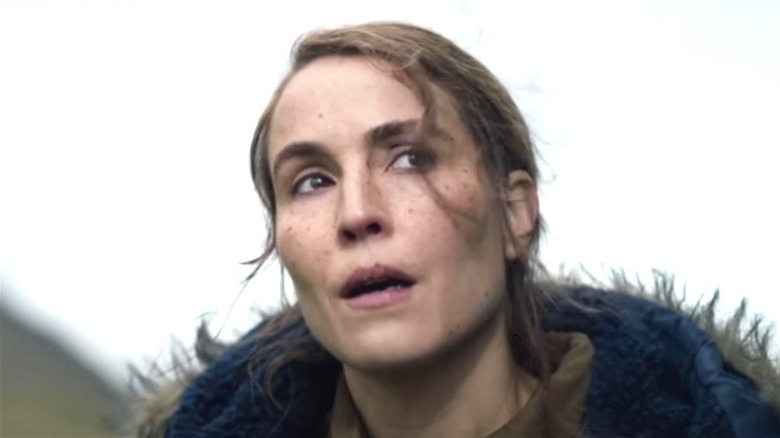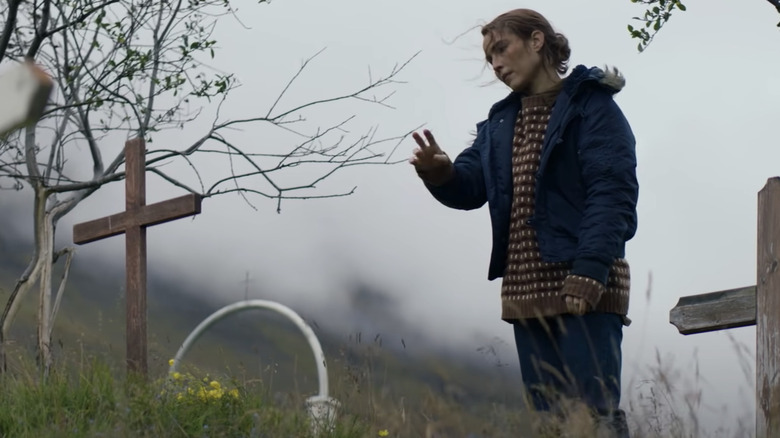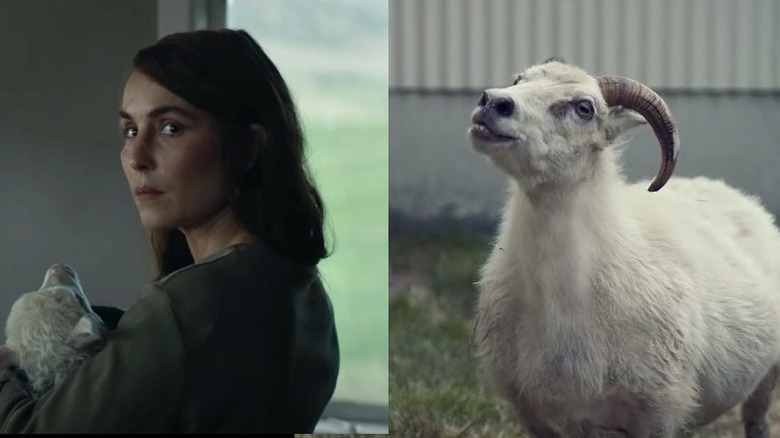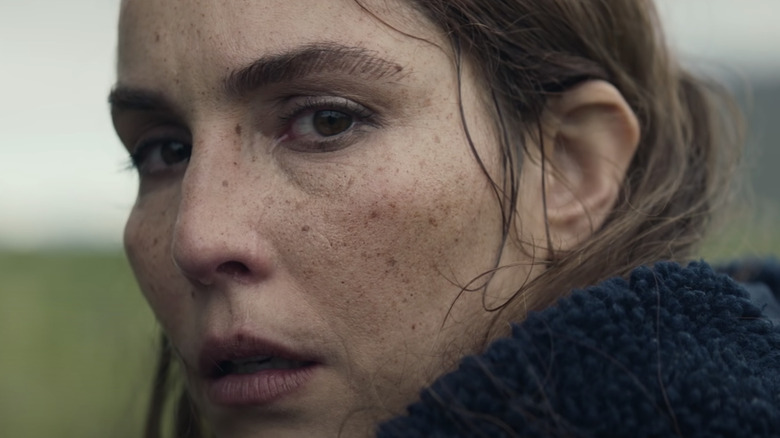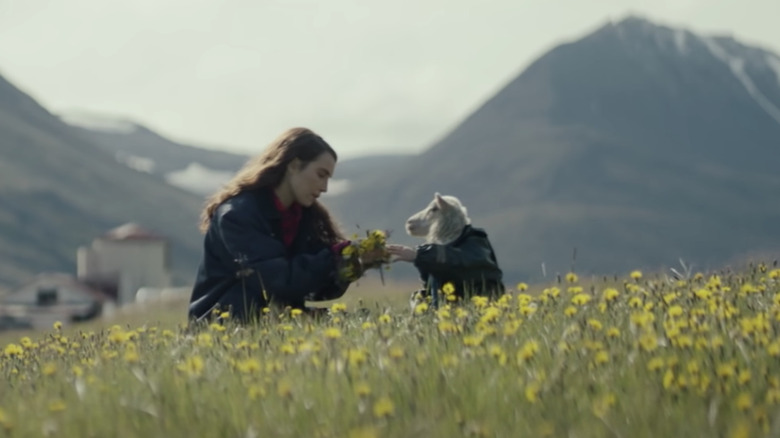The Ending Of Lamb Explained
This article contains spoilers for the movie "Lamb"
Writer/director Valdimar Jóhannsson's nightmare-inducing horror film, "Lamb," arrived in theaters on October 8, promising to disturb audiences with its quiet, unnerving pace and surrealist narrative. Co-written by Sjón and distributed by A24 (of "Midsommar" and "Hereditary" fame), "Lamb" follows Icelandic sheep farmers Maria (Noomi Rapace) and Ingvar (Hilmir Snær Guðnason) as they grieve the loss of their child. In the wake of such a tragedy, the couple is presented with a second chance at parenthood when a sheep gives birth to a lamb with the body of a human baby. (Think The Minotaur of Greek mythology fame, but less horrific and more adorable in an Anne Geddes-meets-"Sweet Tooth" sort of way.)
On paper, such a fantastical plot sounds as though it would lend itself to a simple, one-to-one kind of allegorical interpretation. In reality, Jóhannsson's film ditches the obvious and heavy-handed in favor of nuanced explorations of grief, maternal love, and what it means to be human — all of which, at times, can be every bit as terrifying as the actual monster of the film's finale.
Lamb explores the quiet terror of loss
Although the dialogue-sparse film takes its time explicitly revealing the reason behind the uncomfortable, silent tension between Maria and Ingvar, it's evident from the start that they've suffered something together and have come out the other side a different couple. It's hard not to feel a bit of Robert Frost's "Home Burial" in the pair's dynamic — much like in the poem (via Poetry Foundation), we see the father's grief manifest in an alternately stoic and optimistic focus on the work of the day-to-day while the mother wears her despair like a kind of armor. Maria's loss comes across in the unseen and the unsaid. There's an overwhelming feeling that something is missing. As viewers watch the pair navigate their daily lives, that lack becomes its own character, amplified by the bleak, muted palette of the sprawling Icelandic landscape.
But Maria's paralyzing grief isn't the only thing hanging heavy over the first chapter of "Lamb." The movie tells viewers that something happened in the couple's barn around Christmastime (the time of year when Icelandic sheep breed) and know that something seemingly supernatural took place. Crucially, the couple does not know something strange occurred, which only heightens the audience's anxiety. This discord further isolates the grief-stricken parents, who move from one symmetrical and orderly-framed interior to the next, all while the viewer awaits the inevitable reveal.
Lamb shows the struggle between humans and animals
That reveal comes in the form of a newborn lamb. The audience is unaware of the lamb's human lower half for several scenes. The camera initially shows Maria and Ingvar's astonished reactions to what their sheep has just birthed and their instantaneous, unthinkingly quick "adoption" of the child, which they name Ada. Maria delivers lambs twice in the film's first chapter, but neither prompted the couple to wrap it in a blanket or treat it like a newborn baby. In other words: it's clear there's something different about this lamb, but the dramatic irony is reversed. Now, the couple knows something that the audience does not. It is eventually revealed that this particular lamb possesses the legs, left arm, and torso of a human. As such, it becomes a physical representation of the film's blurring of lines between human and animal.
The lamb's actual mother — a formidable sheep who repeatedly bleats outside the window of the baby's room — becomes Maria in animal form. She, too, has lost her child. What's worse, she knows exactly where that child is, but she cannot retrieve it. The mother sheep's helpless visits to the newborn's room are an echo of Maria's visit to her child's grave; what's lost is lost forever. After Ada goes missing and is found in the fields, freezing in her naked human skin alongside her actual mother, Maria kills the sheep. She knows the lamb doesn't really belong to her, but she can no longer live with the threat of Ada's birth mother. That one mother is a human and one is an animal hardly matters. Their struggle is one and the same.
Lamb's ending is meant to be ambiguous
Maria leaves the house to take her brother-in-law and former lover Pétur (Björn Hlynur Haraldsson) to the bus station to remove him from her family's immediate space. It's the second time Maria rids her home of a perceived threat. While she's out, Ingvar takes Ada on a walk across the sprawling landscape and is shot in the neck by an unseen antagonist, eventually revealed to be Ada's birth father. Like the lamb, he possesses the legs, torso, and left arm of a human. He also has the head of an imposing ram — again, like The Minotaur, but definitely just straight-up horrifying. After fatally wounding Ingvar, the creature takes his daughter by the hand, and they quietly walk away. Maria runs up the hill to find her husband bleeding out on the ground and her child nowhere to be seen.
Here's where the ambiguity comes in. Rather than chase after the Ram Man or make any attempt (however futile) to seek medical attention for her dying husband, Maria first appears confused, then settles into a kind of calm. "It'll be okay," she repeats, "it's okay." As she stares off into the distance (not incidentally, she breaks the fourth wall and looks directly at the camera), Maria seems to glimpse the Ram Man and Ada walking away together.
Of the film's ambiguous ending, Valdimar Jóhannsson tells Inverse, "It can stand for so many things...Even I've changed my mind after watching the film so often." According to Noomi Rapace, "[Maria] somehow always knew the Ram Man [was there] and that Ada [would be] taken away from her." And yet, Maria's acceptance isn't the wholly beneficial "final stage" of grief that we might hope it would be.
The ending of Lamb sees acceptance as a double-edged sword
In that same interview with Inverse, Noomi Rapace explains that her character "takes something that is not hers because she needs to heal," which is why she always knew the Ram Man would come for her Ada. "That's why in the end, her pain is released. She's breathing again; she's alive. It's the beginning of a new chapter. It's extremely painful, but she is there," Rapace shares.
Maria accepts this new loss of both her husband and the child, but it is acceptance in the form of resignation. In grieving the loss of her actual child, Maria may have been (as Rapace notes) merely "surviving" as opposed to "living," but there was something tethering her to her humanity and existence. Now, released from her grief as well as her new child and her partner, Maria is the absolute definition of that line from the song "Me and Bobby McGee"; for her, freedom truly is "just another word for nothing left to lose."
On the one hand, she's shed her pain. On the other, she's simultaneously shed (or, lost) an entire portion of her identity and experience. In this double loss, the ending of "Lamb" suggests that while grief may be lonely and isolating, the death of that grief creates a void equally as terrifying as its presence.
